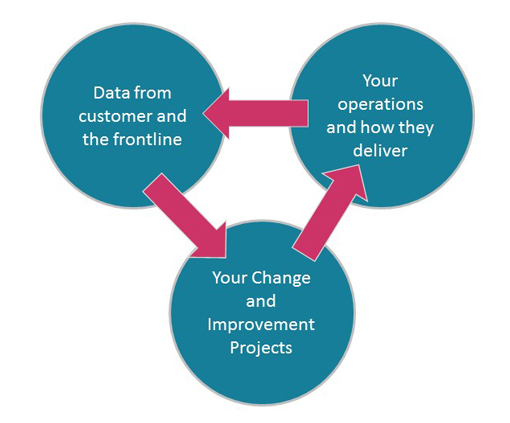In this instalment of our contact centre manifesto series, we investigate how Voice of the Customer (VoC) data can encourage change throughout your business.
The Problem
The data is there – who’s using it?
Contact centres have access to one of the best resources a business could hope to get – Voice of the Customer (VoC) data. By putting this to use, enterprises have the ability to read deeply into what motivates customers, including buying habits, where products need to be improved, complaints triggers, promoter scores, and more.
Technology like interaction analytics makes it more accessible than ever, but unfortunately, this resource is largely squandered. While some companies have learnt how to harvest this data source and feed it back into the business, many more simply sit on it.
Our understanding of contact centres is outdated
The role of the contact centre has changed dramatically in the last two decades. It’s going to keep changing, and the next major shift will be how it deploys the information it gathers.
While currently seen as cost centres among the wider business – a necessary evil – contact centres will increasingly be needed to provide detailed insight.
“It’s a fundamental mistake, the notion that contact can be a separate entity. I don’t ring you up to make contact, I want to get something done. What I need to do is get to the person who can help me. The problem is in the name, ‘contact centre’. By focusing on contact, we’ve lost the plot.” Simon Foot, Group Development Director at Ember Services
Customers get in touch because they have problems that need to be solved, problems that usually originate in some other branch of the business.
Helping other departments improve their approach needs to become a fundamental role of the contact centre. This should be a win-win scenario for all involved, increasing customer loyalty while helping contact centres reduce call volume.
What can we do about this?
It’s clear that a new kind of relationship needs to be built between the contact centre and the rest of the business. Deep structural change does not happen overnight, and you might encounter resistance.
Start with buy-in from the senior leadership team

Asking heads of department to take on more work or change their practices is a hard sell. They might not appreciate the wider value that could be created for the business, and they may even feel that the contact centre exists to deal with problems that they create.
This is why it’s essential to get buy-in from the people with a more holistic view of business performance, above the departmental level. If necessary, take this issue to the company CEO and turn the project into something that can’t be ignored.
“CEO involvement is about more than project sponsorship; it’s about connecting up data and processes.
“Most contact is derived from things that other parts of the business do, so it’s important that the CEO keeps other department leaders attending to contact too. That means all the problems they’re having as well as all the opportunities.” Peter Massey, Managing Director at Budd
How exactly?
Getting buy-in is as simple as demonstrating how benefit outweighs cost.
- Be detailed about your expectations. It’s only by having a clear understanding of what you can accomplish that you’ll convince anyone else
- Find out how much other departments spend on their own VoC schemes. There’s a good chance the business is wasting money by buying the same service twice
- Collect examples of routine contacts created by other department’s processes
- Perform a detailed cost/benefit analysis. Look for interactions that a VoC project could eliminate
- Get benchmarking information about the VoC projects at similar businesses, especially where they have shown good value
“Cost–benefit analysis was how we convinced people, demonstrating the processes that save minutes per day. We looked closely at cost of advisor per hour, so we can look at time savings from eliminating or streamlining certain contacts.” Ruth Mercer, Operations Manager at Hughes Insurance
Make your VoC project interdepartmental
Getting buy-in from the highest level of business is how you will get started, but to maintain a project you will need the enthusiastic support of your colleagues too. This kind of support might be easier to get if you are involving colleagues rather than briefing them – or lecturing them.
That’s far from the only benefit of spreading your efforts. An interdepartmental team will have a much easier time feeding change back where it needs to go, and a better understanding of what shapes processes.
For example, perhaps there is a lot of complicated legal language in your billing that drives contacts. You might like to remove it, but what if this is part of regulatory compliance obligations? It would be better to have that kind of information from the beginning.
Staff secondments are another tool that helps individuals in various areas of the business establish a greater understanding of wider issues. Senior directors often voice the need to avoid silos in the contact centre, and allowing staff to move more easily through the company makes silos easier to spot and to address.
Process-flow diagrams
You can also collaborate to create a much more detailed understanding of your processes and how they interrelate. In particular, a process-flow diagram is both a great teaching tool for agents and a way for each department to easily understand the processes of the others.
The aim should be to create a visualisation that confirms a solid process for any eventuality. You don’t need to contact a colleague every time you have a process question when you can refer to a simple diagram.
At the same time, writing out processes can highlight the ‘baggy’ areas, where they are needlessly complex and lengthy.
Once you have process-flow diagrams, you can associate them with call drivers, which will enable you to identify where the process bottlenecks are.

Driving data insights back into the business starts with establishing a unified view of what the data says, and what it means. That’s why the creation of simple visual tools is beneficial – you can’t force colleagues to use what you provide, but it’s up to them to explain why they would ignore resources that have been made available.
It’s also true that the contact centre doesn’t have a monopoly on VoC data, and that you stand to benefit from their initiatives as well.
And remember, VoC isn’t all about complaints and what needs to change – it’s also about confirming the areas where performance is great, and building on that.
Make departments accountable for the contacts they drive
The first thing is to distinguish between ‘accountability’ and ‘blame’. It’s not helpful for this kind of activity to become accusatory. Departmental tribalism needs to go on the back burner while you work to add greater value to business practice and increase the prominence of the contact centre in decision making.
“A situational example: A contact centre director gets beaten up every Monday morning by the board about the drain of cost that the contact centre is on the business.
“The following Monday, the director goes in and instead says everything is fine with attendance and schedule adherence… But we are currently dealing with an unexpected spike in calls due to the actions of the man on the other side of the table who started a marketing campaign without letting us know!
“This shift in focus, combined with really strong data and stories, and an ability to convince and influence people, will be a step-change in the way the business is run.” Peter Massey
So how should you approach this?
When groups within the business have processes that drive contacts, they need to know about it. In theory, they should be keen to hear what you’ve got to say, so they can build that information back into their own success.
As we’ve already touched on, this doesn’t necessarily hold up in practice.
All you can do is make your intentions clear – improving business processes and the customer experience.
Here is how you can make others aware of their impact:
- Play department heads recorded calls that their campaigns have generated. Make it clear that these are not one-offs, and there are plenty more calls on the same topic. Putting a name and a real experience to the situation will reinforce the point and underline the fact that customers are actually being driven away.
- Start tagging calls against the department where the issues originate. It might take some effort to set this up, but the result will be firm data on the worst offenders. You can display this data in your office and present it in meetings, where it will make a clear statement about who needs to change their approach.
- Calculate the cost of the interactions each department drives. You can offset this against the amount of revenue each department supposedly generates for a more complete picture of their value. You might even be able to recommend a new model of contact centre funding which is sourced proportionally from the operations budgets of other departments.
Stress the point that you are not trying to reduce contacts because it will make your life easier – you’re doing it because a lot of contacts indicates a lot of unsound practices.
The VoC Cycle
We’ve established that the data from a sustained VoC project is only worthwhile if it informs business practice. Too often there is significant disconnect between the data, the projects they spawn, and actual day-to-day practice. The relationship between these three elements forms the ‘VoC cycle’.

The implementation of VoC lessons is sometimes discussed as if it were a one-off project, which might explain the kind of knee-jerk reactions business have. In practice, the data should continually be informing projects to improve customer experience and the practice of operations teams.
Fixing VoC projects means establishing which part of the cycle has fractured – data that isn’t getting analysed, analysis that isn’t shaping projects, or projects that don’t improve customer experience.
Making this ongoing cycle clear to other departments may well help to answer a very common complaint: “Didn’t we do this already?”
“A lot of organisations end up with lots of projects that make no difference, operations people getting swamped with projects, or changes going ahead that customers don’t care about.
“Projects only matter if they are part of a complete cycle, so you need to be good at all three elements. That continuity is what the customer experience or contact centre director needs to be responsible for.” Peter Massey
The importance of surveys

A robust VoC project will gather data from every part of the customer journey. Much of this will be from ‘natural’ interactions like call recordings. The contact centre automatically collects a great deal of data that it can draw on, but an involved analysis means posing specific questions to customers.
“This insight needs to come from a combination of sources, including customer survey feedback and analytics. The data will need triangulating to work out exactly where the root of the problem lies.
“This analysis needs to be granular, otherwise the insight will just fall victim to a ‘get out’ clause with no one taking responsibility.” Peter Massey
Improving your Voice of the Customer Surveys
Here are some ideas for performing surveys that return useful and actionable results.
1. Get your timing right
How long after an interaction should you wait before sending a survey? Well, it really depends on the interaction. If the customer places an order and won’t receive their item for another week, is there really any point surveying them straight away? It makes more sense to wait until their purchase has arrived before you ask them for feedback.
On the other hand, response rates for post-interaction SMS surveys will probably be low if you wait two weeks to send them.
“If you’re measuring a touchpoint it’s fine to survey immediately after that, but set some rules to make sure you’re not surveying the same customers time and time again – particularly if they have a problem and are repeatedly calling to get it fixed.
“Make sure the survey is fit for purpose. If you want to measure fulfilment, it may be better timed a week or two after your customer receives their goods or invoice.” Sam Richardson, Specialist Consultant at Ember Services
2. Don’t involve agents in selection
When asked if agents should decide who gets surveyed, most industry insiders give a firm ‘no’. Yet there are still some environments where this is the norm.
The bottom line is that agents are only human, and they respond to incentives. Their bias, even if it is totally unconscious, will badly affect the quality of your data set. Don’t put them in that situation, and make sure that surveying is either truly random or linked to other triggers beyond the agent’s control.
“We send surveys on the back of certain wrap codes. We don’t do them on the back of a complaint – we send something different – because it’s not useful to get totally negative feedback, and more importantly, the customer does not want to do a survey then.” George Frost, Senior Change and Improvement Manager at OVO Energy
3. Make your surveys a reasonable length
How many questions is the customer really going to answer? As a rule of thumb, three questions is the most customers will answer in post-call IVR or SMS. For other formats a five-question cap is sound, and ten should be the absolute upper limit.
It helps to tell the customer in advance how many questions are in the survey. That way, nobody starts filling it in with false expectations about the time commitment they are making.
“One high street clothing retailer has a great survey. Not only is it fun, but halfway through it asks the customer if they want to continue or if they’ve had enough. Simple but very effective.” Sam Richardson
4. Use your own data to choose participants
The first thing to bear in mind is who you are addressing your questions to. You’ll get a better response rate if there is a strategy guiding which customers you reach out to.
Obviously, surveys should be appropriate to the experiences of the customer. There’s no point asking about facilities that they may not have used, such as self-service portals.
You can base the questions customers receive on their customer journey – are they new, are they making their 10th purchase, or their 10th complaint? You can also use wrap-up codes and text analytics to match customers to different surveys.
One of the quickest ways to put off a customer is to ask them to supply information that you should already have. They might be willing to answer three simple questions but unwilling to fill out an unnecessary contact form.
You also need to have a good sampling strategy to make sure you’re not surveying the same groups too frequently.
5. Be mindful of your customers
There’s no ‘best way’ to gather survey data – it depends on your resources, the size of your customer base, and the kind of information you need. But you do need to think about what the customer is likely to be doing when you make contact, and whether it’s appropriate to get in touch.
Avoid mandatory questions, or at least include an N/A field in case the customer can’t answer.
It’s always worth including a text field where customers can write whatever else they need to – this is frequently the most useful part of the entire survey, because it covers the things you didn’t think of.
“One international airline brand sends SMS survey requests to its customers the minute they land at their destination. After a long-haul flight, this is not something customers are keen to do (or pay for).” Sam Richardson
6. Separate surveys for process and service
Your survey questions should be clear and to the point. A customer might receive great service from an agent but still not get what they expected from your business.
“We expect there to be correlation between what the customers say and what our evaluation says. There is also a matter of process and what agents are empowered to do, and the two will not always meet up. That means that while the customer’s perfectly happy, a process was not followed, or vice versa.” Dan Moross, Director of Customer Experience at MOO
7. Respond to negative feedback
Negative survey feedback is a blessing in disguise. When you receive an unflattering response from a customer, that’s when you should be most glad that you made the effort to survey.
If you find out that a customer is not happy, that’s your cue to get involved. Many businesses gather data, but not all of them know how to act on it. One of the key reasons to survey customers is the opportunity to turn a negative experience into a positive one.
“If anyone leaves a negative comment a senior team member gets back to them. Calling back the unsatisfied customers boosts retention and helps the team to understand what the specific problem was and what caused it.
“In many respects, it’s a bit of a safety net having that feedback process in place, because it catches the customers and puts them back in the mix.” Dan Moross
Another great way to get customer feedback is by hosting a focus group. You can find out more about how to arrange that here.
Change the attitude to the contact centre

VoC is not a one-off campaign that you later discard. It’s an ongoing process that not only integrates data into the wider enterprise but changes what the contact centre is there for.
The broken theory is that contact centres are the remote part of the business that handles complaints. But in reality, the contact centre is the customer-facing branch of every other department.
Managers need to recognise that the strategies of IT, Marketing, or Sales are necessarily part of the contact centre strategy too. This shift in attitudes has to originate in the contact centre itself.
Everyone from frontline agents to the director of customer service must put aside the habitual understanding of what a contact centre is for and start thinking about what other functions it can serve.
“Marketing is acknowledged as a profession in a way that the contact centre isn’t yet.
“They’re good at making a demonstrable claim to success, and have been able to establish themselves as a discipline.
“Contact centre operations tend to focus on ‘cost down’ behaviours of doing more for less, whereas Marketing will talk about revenue and generating demand. We need to communicate the risk to revenue, customer journey and reputation when budget cuts are on the table!
“The customer experience is lousy because the board doesn’t understand it, and we are unable to articulate what we’re about. As an industry, we don’t see ourselves as a profession.” Simon Foot
This article forms part of The Contact Centre Manifesto series
The following ideas have been discussed with the industry experts pictured below:

[left to right] Simon Foot, Group Development Director at Ember Services, Peter Massey, Managing Director at Budd, Ruth Mercer, Operations Manager at Hughes Insurance Ltd, Sam Richardson, Specialist Consultant at Ember Services, George Frost, Senior Change and Improvement Manager at OVO Energy, Dan Moross, Director of Customer Experience at MOO and Ann-Marie Stagg at the Call Centre Management Association (CCMA)
For more insight into how we can reposition the contact centre, so other departments recognise its value, read our article: Call Centre Management: From Cost Centre to Strategic Resource
Author: Rachael Trickey
Published On: 22nd Jun 2016 - Last modified: 22nd Jul 2024
Read more about - Customer Service Strategy, Contact Centre Manifesto, Peter Massey, Voice of the Customer















The bottom line is, and will always be, to listen to your customers. It’s not all the time that the agent would be mindful of the buying signals and other implications on how the customer regards the company and their product(s) and/or service(s), but you’re right when you said management and team leaders should step up and help looking for ways to investigate those. The VoC is one data contact centers should not ignore if they want a more effective process and higher customer satisfaction rate.